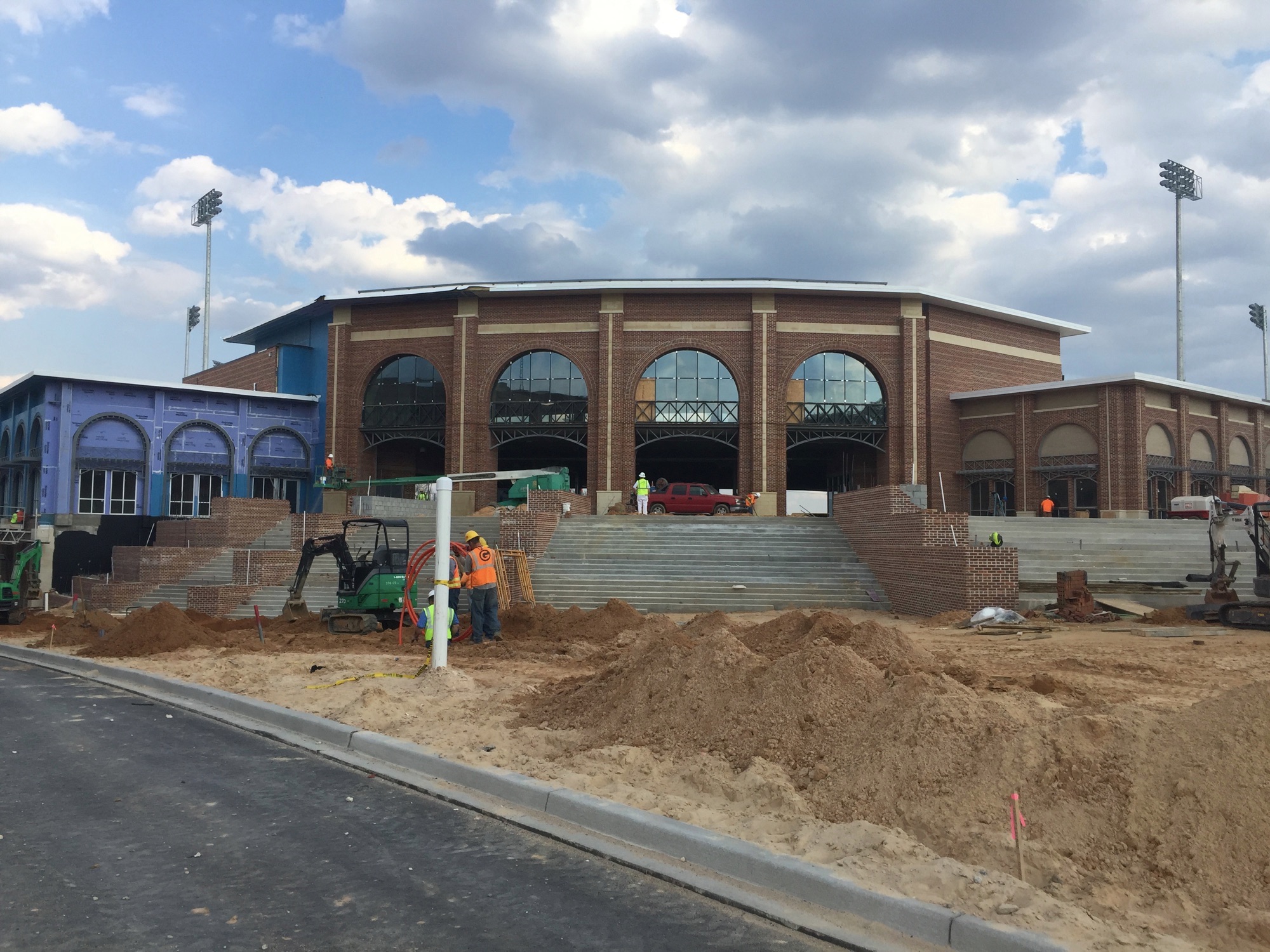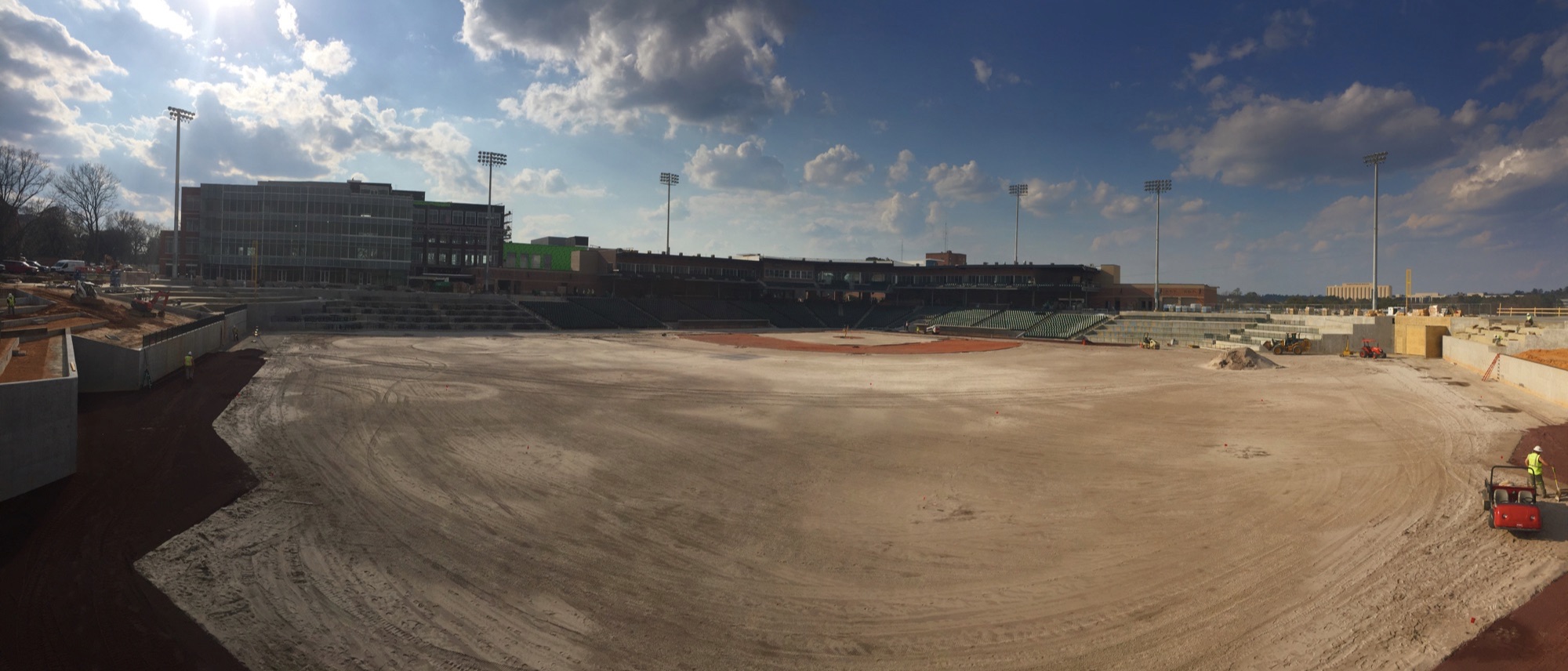Of the upcoming opening days and ballpark introductions in Minor League Baseball, few will be as highly anticipated as Spirit Communications Park, new home of the Columbia Fireflies (Low A; Sally League). After an 11-season absence, South Carolina’s capital city is set to embark on a baseball experience that operators and planners are hoping will be among the best in the minors.
The Fireflies are owned by Hardball Capital, the group that also owns the Chattanooga Lookouts (Class AA; Southern League) and the Fort Wayne TinCaps (Low A; Midwest League). The TinCaps have been a perennial success since their downtown ballpark—Parkview Field—opened in 2009, making them a model for other communities and teams. Following the Fort Wayne project, Hardball was looking to build downtown ballparks in Columbia and Savannah, where a waterfront stadium concept was floated for the Savannah Sand Gnats. The two-city proposal was considered up until last year, but after Savannah passed on the effort, Hardball announced that it would move the Sand Gnats to Columbia.
“It was disappointing from the aspect that we thought we could do really good things in both markets,” says Fireflies president John Katz of his initial reaction to the move. “But once it was clear that things weren’t going to happen in Savannah, it turned into a lot of enthusiasm,” for returning a minor-league team to the “baseball-rich” Columbia market. “It’s kind of an honor to all of us to get to bring it back to town, but you have to do more than just bring it back. You have to exceed everyone’s expectations.”
Katz, who joins the club from Savannah, said that he and other Hardball officials started the planning process for Spirit Communications Park by tracing back to Parkview Field and assessing its amenities. They gathered insight from everyone in Fort Wayne—from fans to employees—and combined that feedback with their own evaluation of the stadium. The question they were left with: “great, [Parkview Field] works well, but what we can we do better?”
“We want to make it Columbia’s ballpark, not Fort Wayne’s ballpark,” said Hardball CEO Jason Freier. Just as he had during the preplanning phases of Parkview Field—when he visited about 70 ballparks—Freier spent time traveling to other facilities to evaluate certain design trends around the minors. While familiar features from modern ballparks—such as 360 concourses and state-of-the art technology—are evident in Spirit Communications Park, Freier wanted something unique.
Different Seating for Different Fans
To jumpstart the effort, Hardball reteamed with Populous. “We have a good rapport,” said senior architect Mike Sabatini, who characterized the firm as eager to once again collaborate with Hardball and Freier. “He understands baseball and the business of baseball. He also knows what works, and what doesn’t work over time.”
While there are some nods to Parkview Field within Spirit Communications Park, the final result is one that is true to Columbia. Spirit Communications Park is a cornerstone for the roughly 165-acre Columbia Commons development, which is located on the former site of the South Carolina State Hospital campus on Bull Street.
“Every ballpark should be a product of its environment,” said Freier, who said that both he and Populous felt that the site of Spirit Communications Park offered plenty of ideas. In this case, one of the main sources of inspiration were a series of historic red-brick structures that will be preserved and reused as part of the development.
“The idea of trying to maintain the landscape makes the ballpark very intimate,” said Sabatini. Details such as brick patterns, colors, and openings within the building have inspired the look of Spirit Communications Park, which will be characterized by its ornate red brick exterior. Sabatini said that the “focal point” of the stadium is the main entrance. Located behind home plate, this elevated gateway features a large outdoor plaza and red brick archways that will make it unique in comparison to other ballparks.
Even inside, detailed steps have been taken to assure that Spirit Communications Park remains unique among minor-league facilities. The stadium features what Sabatini describes as “neighborhoods of seating” that will allow for 9,000 fans for baseball events. Along with a traditional seating bowl, the ballpark will feature an outfield berm, group areas down the left and right field lines, a home run porch in left field, and a 7,000 square foot club area.
“We’re really good about—and Jason is cognizant about—providing different types of seating for different types of fans,” said Sabatini. The larger plan with Columbia was to tap into the ongoing trend across ballpark construction—both for new and renovated facilities—of offering more diverse, and social seating options.
When asked why he prioritizes this seating concept, Freier pointed out two main reasons. “To make a ballpark interesting, because people aren’t going to be diehard fans like they are in the big leagues, you have to provide a variety of experiences.” In essence, the Fireflies want fans who visit Spirit Communications Park multiple times a season to have a new option each time, whether it is buying a ticket in the seating bowl, coming as part of the group, or taking in a game from the outfield berm.
Additionally, Freier noted that group areas should be designed to fit the needs of the mark. Columbia offers a wide range of potential clients, from large businesses, families, and church groups, to small businesses, University of South Carolina students, and military members from nearby Fort Jackson. Just as it had in Fort Wayne, Hardball considered the needs of each base and sought to build areas that were tailor made for their outings. “You don’t want to design the ballpark and then say ‘who are my clients’ and then find out that the ballpark isn’t great for the groups, businesses, and churches in your market.”
A Year-Round Resource
A few other priorities will be apparent, including Hardball’s objective to make sure that the stadium is a year-round destination. The seating bowl has been configured in a way that will allow for not only good sightlines for baseball games, but also for football and soccer.
“For football here at Spirits Communications Park, we will have 5,000-6,000 great seats because the field will run along the first base line,” said Katz. He also anticipates that soccer games, because they’re played on a wider pitch, will be able to utilize seats in left field.
Additionally, the 360-degree concourse will be open year-round and act as a section for a jogging trail. The club level will also serve as year-round gathering spaces, with the ability to accommodate large weddings and other events.
Whether it is for joggers to take a stroll around the concourse or for a group to utilize the club level, Sabatini says there is a certain formula he wanted to implement. “You have to build flexibility into the facility, and a little bit of transparency.”
Fans will also have access to some of the most modern technology available. The ballpark will feature two ribbon boards, as well as a 1,500 square foot high-definition videoboard that Katz says will offer “the latest and greatest replay modules.” He added that he was pleased with the work done thus far by video production manager Jared Law, who has been tapped to develop an innovative package that will boost the entire entertainment operation, ranging from instant replays to the graphics.
As part of the sponsorship with Spirit Communications, the team will offer free Wi-Fi via 86 access points throughout the ballpark. “We talk a lot about how we’re engaging the fans, and how people are engaging themselves,” said Katz, who noted that the Fireflies made it a priority to tap into the increasing use of social media across all ages.
With the changing technology comes a different set of standards and new competition for operators, which is why the trends of social media nights and videoboard prompts for social networking are only growing around the industry. Katz feels that the Fireflies are poised to tap into this development by mending the digital and game day experiences. “If you’re not providing that service and that access, you’re selling yourself short.”
Sabatini, whose portfolio includes recent Ballpark Digest award winners Southwest University Park and CenturyLink Sports Complex (as well as Citi Field, home of Fireflies parent New York Mets), said that the support from Columbia’s leaders and residents made this experience enjoyable. “As a college town, they really rally around each other,” said Sabatini, who added that Bob Hughes, the developer behind the Columbia Commons project, has been a consistent backer of the ballpark.
Katz said that the team’s goal from the beginning has been to develop an experience that is identifiable with Columbia. The uniform and logo scheme—which has received significant attention around the baseball landscape—was part of this objective, as the name Fireflies is inspired by the spring synchronization of the insects at nearby Congaree National Park. “We wanted to make sure we were different. The Fireflies brand story is so good and so unique to Columbia.”
“One of the important things you can do, along with providing the right ballpark and the right services, is providing the fans an identity they can embrace,” said Freier. One of the things that he and other Hardball officials were conscious of was making sure that the Fireflies brand did not too closely resemble those of their other teams. “More than anything, I didn’t want people in Columbia to feel like we were doing the same thing from somewhere else. We were trying to start from scratch and make this Columbia’s team.”
Once Spirit Communications Park opens, Katz says that he and the Fireflies staff will work to ensure that fans are given tailor-made and enjoyable experiences on a night-in, night-out basis. “Our organization prides itself on elevating the fan experience. That’s really what people need to expect.”
Images — taken this week — courtesy Columbia Fireflies.



